Reporting Dashboard
The City of Spruce Grove’s Reporting Dashboard uses key data to monitor and share important information about our community and the City’s programs and services. It tracks data over time, telling us what we're doing well and where more focus and attention may be needed. The dashboard groups data sets into themes and identifies targets and/or trends for each data set.
The information provided on this web page is “as is” and “as available” at the time of publishing. The City of Spruce Grove cannot guarantee its accuracy or completeness.
Explore
- Population
- Development
- Permits
- Infrastructure
- Economy
- Safety
- Website and social media
- Environment
- Transit
- Finances
 Trend is increasing
Trend is increasing Trend is decreasing
Trend is decreasing Trend remains the same
Trend remains the same
Population and demographics
-
Population 2025 41,039 residents 

-
Median age 2023 38.0 years old 

-
Avg. household size 2023 2.6 
-
Explore the
Census Dashboard
Development and construction
-
Building permits Q3 2025 293 permits 

-
Building permit construction value Q3 2025 $63 million 

-
New dwelling units Q3 2025 132 units 

Residential new construction building permit processing times
-
Single detached dwellings Q3 2025 3.5 business days 

-
Semi-detached dwellings Q3 2025 3.4 business days 
-
Row houses Q3 2025 4.0 business days 
Residential new construction development permit processing times
-
Single detached dwellings Q3 2025 3.5 business days 

-
Semi-detached dwellings Q3 2025 4.8 business days 
-
Row houses Q3 2025 7.0 business days 
Infrastructure
-
Water loss 2024 3.7%* *Target: <10% 


Local economy
-
Retail vacancy rate Sep. 2025 1.0% 


-
Office vacancy rate Sep. 2025 5.5% 

-
Industrial vacancy rate Sep. 2025 1.5% 

-
Business licences Sep. 2025 1,543 

Community safety
-
Fire services response time 2024 89.3%* of the time target met *Target: 90% of the time 320 seconds or less 

-
Fire-related calls Q3 2025 240 

-
Medical-related calls Q3 2025 1,604 


-
Enforcement complaints Q3 2025 1,418 

-
Enforcement charges Q3 2025 877 

-
Intersection collisions 2024 290 

Website and social media
-
Website Q3 2025 397,222 visits 


-
Facebook Sep. 2025 17,924 followers 

-
Instagram Sep. 2025 6,225 followers 

-
LinkedIn Sep. 2025 6,718 followers 

-
CityPulse subscribers Sep. 2025 1,412 subscribers 


Environment
-
Residential solid waste collected (black bin) Q3 2025 172 average kg per household 

-
Residential recycling collected (blue bag) Q3 2025 22 average kg per household 


-
Residential organics collected (green bin) Q3 2025 100 average kg per household 

-
Residential solid waste diverted from landfill 2024 32.6% 


-
Solar energy produced Q3 2025 119.3 megawatt hours (MWh) 

-
GHG emissions prevented from solar energy produced Q3 2025 58 tonnes of carbon dioxide equivalent (tCO2e) 

Transit
-
On-demand transit Q3 2025 19,349 passenger trips 


-
Commuter transit Q3 2025 36,710 passenger trips 

-
Ridership per capita 2024 3.2 passenger trips 

-
Vehicle hours per capita 2024 0.42 vehicle hours 

Finances
-
Property assessment split 2025 83/17 residential vs. non-residential 


-
Property tax revenue split 2025 75/25 residential vs. non-residential 


-
Real assessment growth 2025 3.90% 


-
Debt outstanding 2024 $77 million 


About this data
This data represents the population estimate for the city based on the latest and historical data from municipal and national censuses as well as estimates based on growth projections.
How we measure this data
As part of the municipal census, enumerators gather data from residents. Every five years Statistics Canada conducts a national census, which provides population estimates for the city. Population from Statistics Canada is reported based on the census subdivision (CSD) which is an area treated as an equivalent to a municipality for statistical purposes. For non-census years, population is estimated based on regional and provincial population growth projections.
Why this measurement is important
The data helps the City understand immediate and future needs and to plan for recreational spaces, community facilities, roadways, maintenance and equipment, emergency services, waste management and more.

About this data
The median age provides an important single indicator of the age distribution of a population. It provides the age ‘midpoint’ of a population; there are the same number of people who are older than the median age as there are younger than it.
How we measure this data
Every five years Statistics Canada conducts a national census, which provides age-related data for the city.
Why this measurement is important
The data helps the City understand immediate and future needs and to plan for recreational spaces, community facilities, roadways, maintenance and equipment, emergency services, waste management and more.
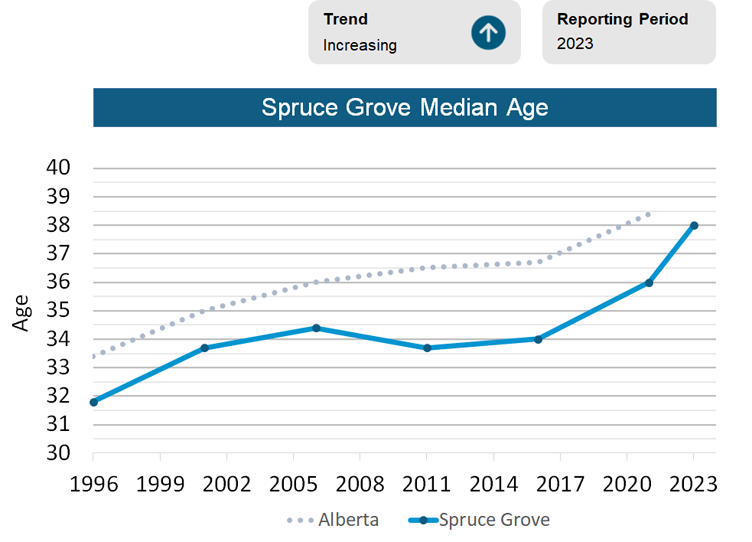
About this data
Average household size is defined as the average number of persons per housing unit. It is the average number of people living per household.
How we measure this data
Every five years Statistics Canada conducts a national census, which provides the average household size for the city.
Why this measurement is important
The data helps the City understand immediate and future needs and to plan for recreational spaces, community facilities, roadways, maintenance and equipment, emergency services, waste management and more.

About this data
This data shows the total number of all building permits issued including residential and non-residential.
How we measure this data
It is calculated by adding up all the building permits issued.
Why this measurement is important
It provides insight on the magnitude of current construction, which is an indicator of the overall economic growth of the city.

About this data
This data shows the total construction value of all building permits issued including residential and non-residential.
How we measure this data
It is calculated by adding together the total construction dollar value of all building permits issued.
Why this measurement is important
It provides insight on the magnitude of current construction, which is an indicator of the overall economic growth of the city.

About this data
The retail vacancy rate describes the percentage of commercial retail space that is unoccupied and available for lease at a particular time.
How we measure this data
As reported by CoStar Group.
Why this measurement is important
It provides insight on the availability and demand for leasable commercial retail space, which is an indicator of the overall economic health of the city.

About this data
The office vacancy rate describes the percentage of commercial office space that is unoccupied and available for lease at a particular time.
How we measure this data
As reported by CoStar Group.
Why this measurement is important
It provides insight on the availability and demand for available commercial office space, which is an indicator of the overall economic health of the city.

About this data
The industrial vacancy rate describes the percentage of available industrial space that is unoccupied and available for lease at a particular time.
How we measure this data
As reported by CoStar Group.
Why this measurement is important
It provides insight on the availability and demand for available industrial space, which is an indicator of the overall economic health of the city.
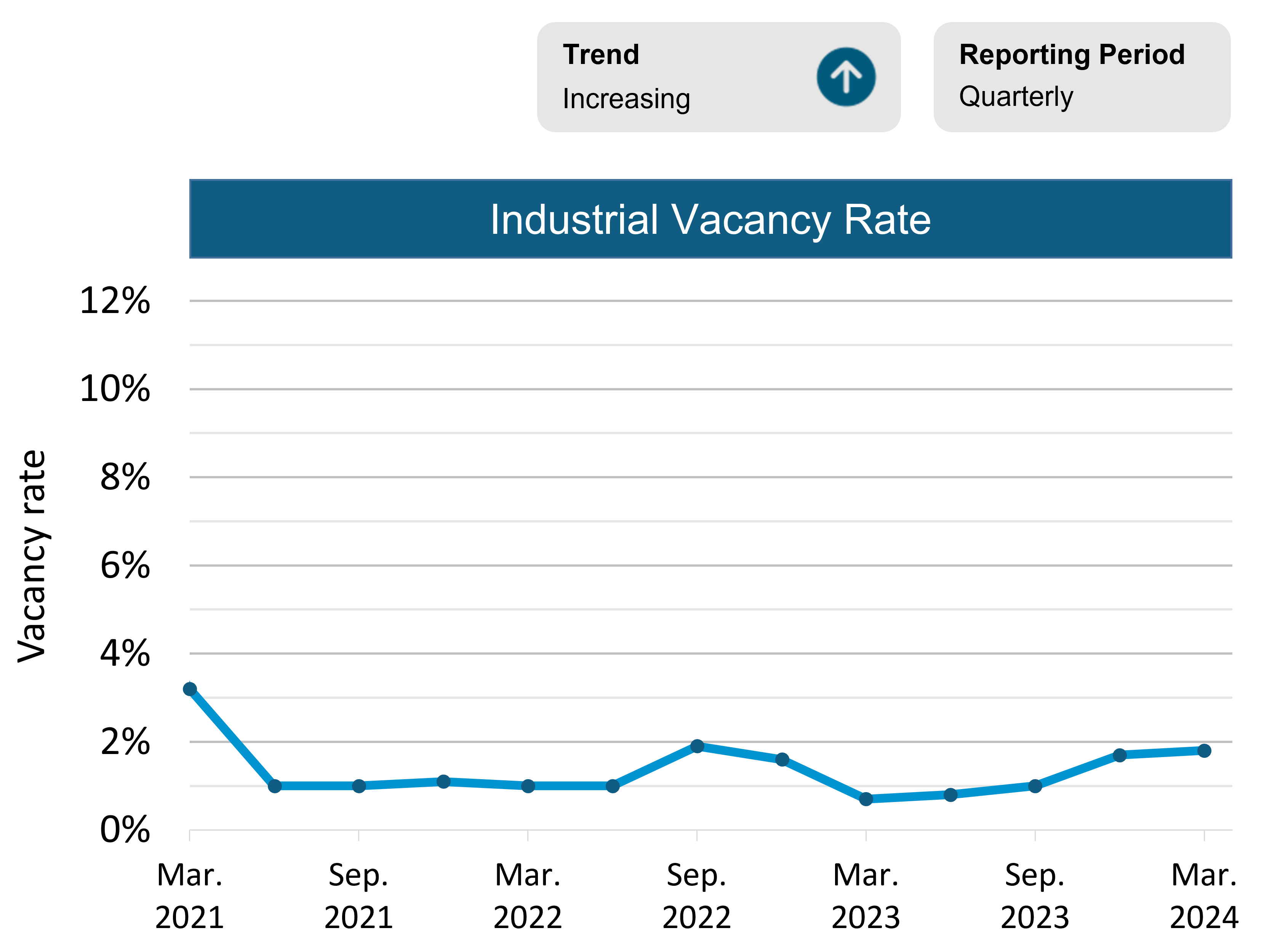
About this data
This data represents the fire-related call volume.
How we measure this data
Total number of fire-related calls received.
Why this measurement is important
It provides insight into the overall pattern of responses and demand for response services.

About this data
This data represents the percentage of time the Total Response Time target was met.
How we measure this data
Total Response Time is calculated by adding together the dispatch time, the turnout time, and the travel time. It represents the time interval from the receipt of the initial call for assistance at the dispatch centre, until the arrival of the responding unit at the incident.
Why this measurement is important
It is measured to evaluate and benchmark against international standards, provincial regulation, and City policy. It helps assess department’s response availability, optimize its capability, and evaluate operational effectiveness.
About this data
This data represents the percentage of time the Call Dispatch Time target was met.
How we measure this data
It is calculated by measuring the time interval from the receipt of the initial call for assistance at the dispatch centre to when the dispatch centre provides an address to respond to.
Why this measurement is important
It is measured to evaluate and benchmark against the NFPA standard and for reporting purposes.
About this data
This data represents the percentage of time the Response Time target was met. Response time represents the turnout time and travel time added together and does not include dispatch time.
How we measure this data
It is calculated by measuring the time interval from when the dispatch centre provides an address to respond to until the first unit's arrival on the scene.
Why this measurement is important
It is measured to evaluate and benchmark against international standards, provincial regulation, and City policy. It helps assess department’s response availability, optimize its capability, and evaluate operational effectiveness.

About this data
This data represents the medical-related call volume.
How we measure this data
Total number of medical-related calls received.
Why this measurement is important
It provides insight into the overall pattern of responses and demand for response services.

About this data
This data represents the number of citizen-initiated and officer-initiated complaints.
How we measure this data
Total number of all complaints received through the various reporting options including online, phone, and front-counter.
Why this measurement is important
It provides an indication of residents' general compliance with bylaws and assesses community safety. It also provides insight into the overall pattern of complaints and demand for enforcement services.

About this data
This data represents the number of charges laid.
How we measure this data
Total number of charges laid as a result of both citizen-initiated and officer-initiated complaints.
Why this measurement is important
It provides an indication of residents' general compliance with bylaws and assesses community safety.

About this data
This data represents the year-over-year year-to-date comparison of the total number of website pages viewed.
How we measure this data
Total number of pages viewed on the City's website. Repeated views of a single page are counted.
Why this measurement is important
It measures the size of our online audience which indicates the number of people who may access information on the City’s website.

About this data
This data represents the number of users who follow the City's Facebook page.
How we measure this data
As reported by Facebook. Prior to 2022 Facebook page popularity was measured by “Likes”. Facebook has since changed that measurement for certain types of pages, including the City’s, to “Followers”. Although these metrics are similar, the data is different enough that comparing previous years is not accurate.
Why this measurement is important
It measures the size of our online audience which indicates the number of people who may see the City’s posts in their feed.
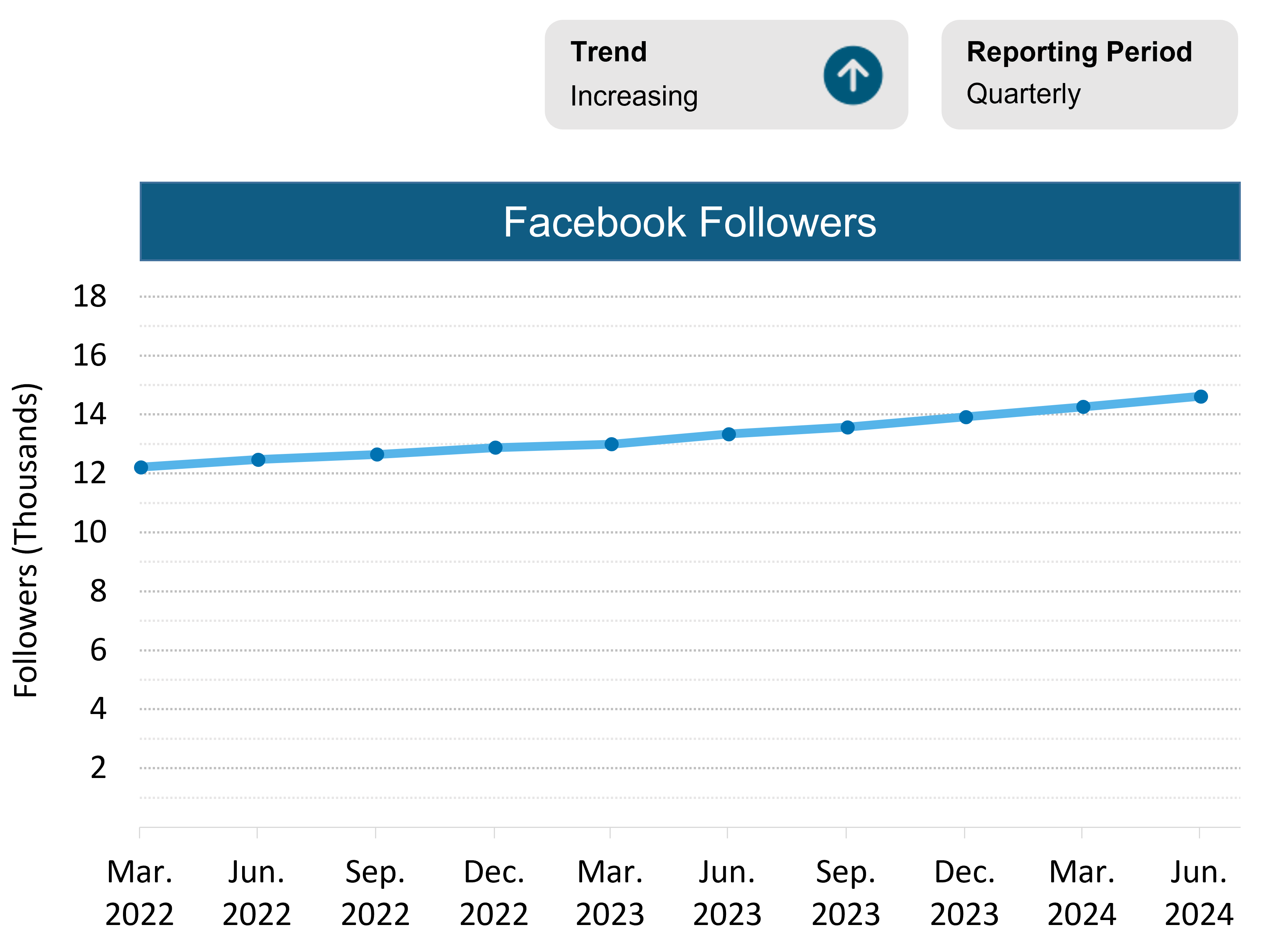
About this data
This data represents the number of users who follow the City's Instagram page.
How we measure this data
As reported by Instagram.
Why this measurement is important
It measures the size of our online audience which indicates the number of people who may see the City’s posts in their feed.

About this data
This data represents the number of users who follow the City's LinkedIn page.
How we measure this data
As reported by LinkedIn.
Why this measurement is important
It measures the size of our online audience which indicates the number of people who may see the City’s posts in their feed.

About this data
This data represents the number of users who follow the City's X page.
How we measure this data
As reported by X.
Why this measurement is important
It measures the size of our online audience which indicates the number of people who may see the City’s tweets in their feed.

About this data
This data represents the year-over-year year-to-date comparison of the average household curbside black bin solid waste collected in kilograms (kg).
How we measure this data
It is calculated by taking the total weight of black bin solid waste collected in kilograms from households in a given period and dividing by the total number of households.
Why this measurement is important
It is measured to determine the overall effectiveness of the City's residential solid waste diversion programs.

About this data
This data represents the year-over-year year-to-date comparison of the average household curbside blue bag recycling collected in kilograms (kg).
How we measure this data
It is calculated by taking the total weight of blue bag recycling collected in kilograms from households in a given period and dividing by the total number of households.
Why this measurement is important
It is measured to determine the overall effectiveness of the City's residential solid waste diversion programs.

About this data
This data represents the year-over-year year-to-date comparison of the average household curbside green bin organics collected in kilograms (kg).
How we measure this data
It is calculated by taking the total weight of green bin organics collected in kilograms from households in a given period and dividing by the total number of households.
Why this measurement is important
It is measured to determine the overall effectiveness of the City's residential solid waste diversion programs.

About this data
This data represents the proportion of curbside waste diverted from the landfill through programs such as organics and blue bag recycling.
How we measure this data
Residential waste diversion is calculated by dividing the total amount of organics and recycling collected at the curbside by the total waste collected at the curbside and represents the proportion of waste diverted from the landfill. The data does not include the amounts collected at the Eco Centre.
Why this measurement is important
It is measured to determine the overall effectiveness of the City's residential solid waste diversion programs.

About this data
This data represents the total number of passenger trips made on the on-demand transit service.
How we measure this data
As reported by the City's service provider.
Why this measurement is important
This data provides insight on the relative demand for public transportation.

About this data
This data represents the total number of passenger trips made on the commuter transit service.
How we measure this data
As reported by Edmonton Transit.
Why this measurement is important
This data provides insight on the relative demand for public transportation.

About this data
This data represents the number of requests for services related a spectrum of housing needs including access to emergency shelter, temporary and long-term housing options, and support with tenancy breakdown.
How we measure this data
Reported from the Family and Community Support Services Information and Referral front desk, as well as from new and existing clients as supported through the Case Management Program and Regional Housing Program.
Why this measurement is important
It provides insight on the demand for housing needs and other related social support services in the community.
About this data
This data represents the number of requests for support in accessing provincial and federal government financial benefits.
How we measure this data
Reported from the Family and Community Support Services Information and Referral front desk, as well as from new and existing clients as supported through the Case Management Program.
Why this measurement is important
It provides insight on the demand for financial benefits and other related social support services in the community.
About this data
This data represents the number of requests for services related to mental health and wellness programs and services.
How we measure this data
Reported from the Family and Community Support Services Information and Referral front desk, as well as from new and existing clients as supported through the Case Management Program.
Why this measurement is important
It provides insight on the demand for mental health and wellness programs and services and other related social support services in the community.
About this data
This data represents the number of requests for support related to access to food, clothing, transportation, and other one-time expenses.
How we measure this data
Reported from the Family and Community Support Services Information and Referral front desk, as well as from new and existing clients as supported through the Case Management Program.
Why this measurement is important
It provides insight on the demand for services related to basic needs and other related social support services in the community.
About this data
How we measure this data
Why this measurement is important
About this data
The data represents the proportion of tax revenue that comes from residential vs. non-residential ratepayers.
How we measure this data
The proportion of tax revenue that comes from residential vs. non-residential ratepayers is calculated annually after the final tax rates have been determined.
Why this measurement is important
It provides insight on achieving financial sustainability and maintaining reasonable and competitive levels of taxation for both residential and non-residential ratepayers.

About this data
The data represents the number of local businesses with an active business licence. It includes contractors, home occupations, and non-profit organizations and excludes temporary businesses and mobile vendors.
How we measure this data
Total number of businesses with an active resident business licence at the end of each quarter.
Why this measurement is important
It provides insight on the overall economic health and growth of the city.

About this data
The data represents the typical total customer wait time for residential new construction permit issuance (building, development and lot grading permits combined).
How we measure this data
Permit processing time is calculated from the time a complete development permit application is submitted to when the associated building and lot grading permits are issued. To calculate the average 90th percentile, the top 10% of outliers are removed and an average is performed on the remaining values. This provides the most common wait time that most customers would experience.
Why this measurement is important
It is measured to evaluate and monitor the efficiency of permit services and to create transparency around permit processing times.

About this data
The data represents the typical total customer wait time for residential improvement permit issuance requiring a development permit (building permit and development permit combined).
How we measure this data
Permit processing time is calculated from the time a complete development permit application is submitted to when the associated building permit is issued. To calculate the average 90th percentile, the top 10% of outliers are removed and an average is performed on the remaining values. This provides the most common wait time that most customers would experience.
Why this measurement is important
It is measured to evaluate and monitor the efficiency of permit services and to create transparency around permit processing times.

About this data
The data represents the typical total customer wait time for residential improvement permit issuance not requiring a development permit (building permit only).
How we measure this data
Permit processing time is calculated from the time a complete building permit application is submitted to when the building permit is issued. To calculate the average 90th percentile, the top 10% of outliers are removed and an average is performed on the remaining values. This provides the most common wait time that most customers would experience.
Why this measurement is important
It is measured to evaluate and monitor the efficiency of permit services and to create transparency around permit processing times.

About this data
The data represents the typical total customer wait time for non-residential improvement permit issuance requiring a development permit (building permit and development permit combined).
How we measure this data
Permit processing time is calculated from the time a complete development permit application is submitted to when the associated building permit is issued. To calculate the average 90th percentile, the top 10% of outliers are removed and an average is performed on the remaining values. This provides the most common wait time that most customers would experience.
Why this measurement is important
It is measured to evaluate and monitor the efficiency of permit services and to create transparency around permit processing times.
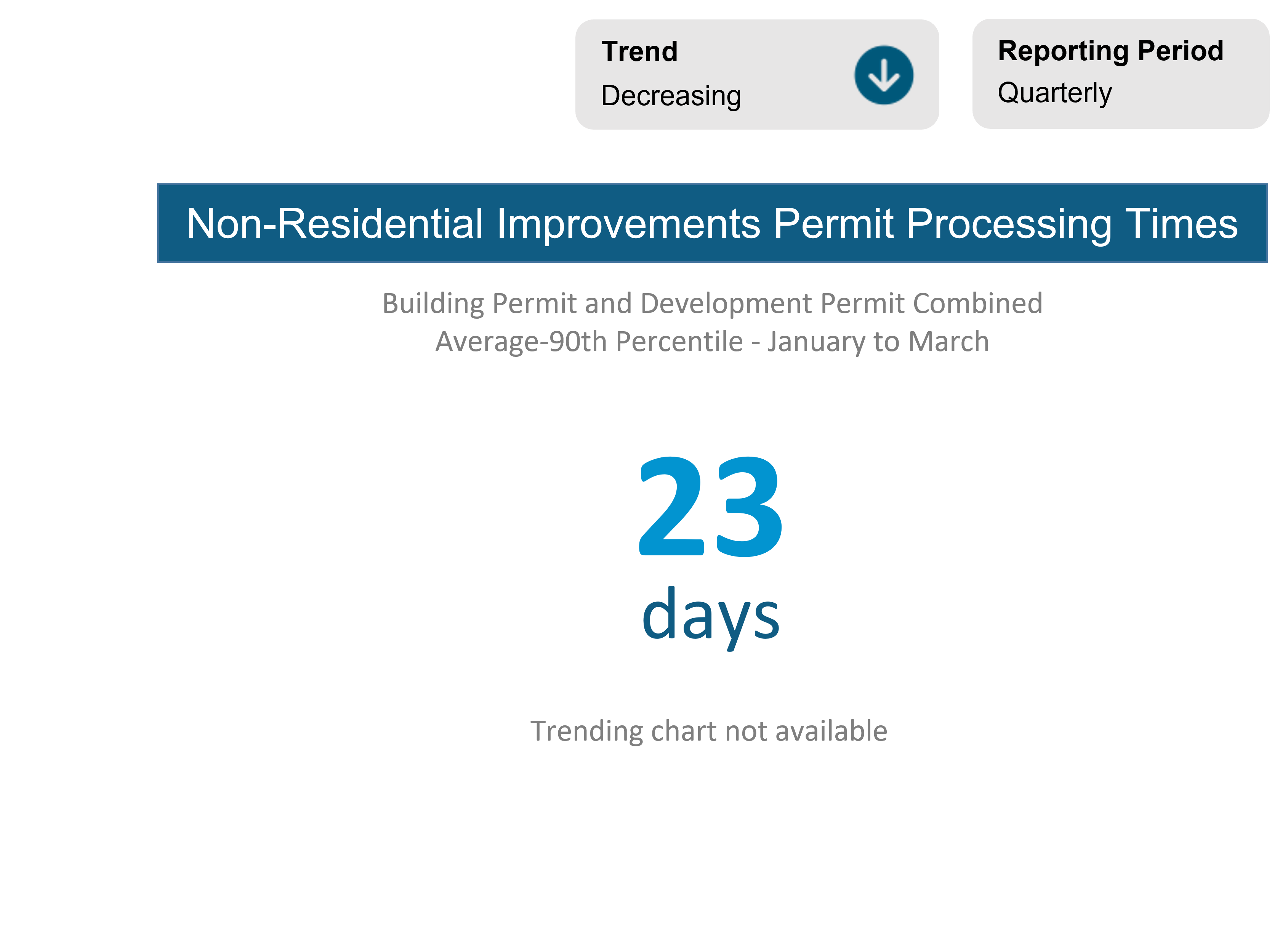
About this data
The data represents the typical total customer wait time for non-residential improvement permit issuance not requiring a development permit (building permit only).
How we measure this data
Permit processing time is calculated from the time a complete building permit application is submitted to when the building permit is issued. To calculate the average 90th percentile, the top 10% of outliers are removed and an average is performed on the remaining values. This provides the most common wait time that most customers would experience.
Why this measurement is important
It is measured to evaluate and monitor the efficiency of permit services and to create transparency around permit processing times.

About this data
The data represents the proportion of total property assessment value that comes from residential and non-residential assessment for Spruce Grove.
How we measure this data
The proportion of property assessment that comes from residential vs. non-residential properties is calculated annually after the assessment data for all properties is available. Assessment values are based on market values as of July 1 of the previous year.
Why this measurement is important
It is measured to assess the growth in the residential vs. non-residential sectors and provides insight on achieving financial sustainability and maintaining reasonable and competitive levels of taxation.
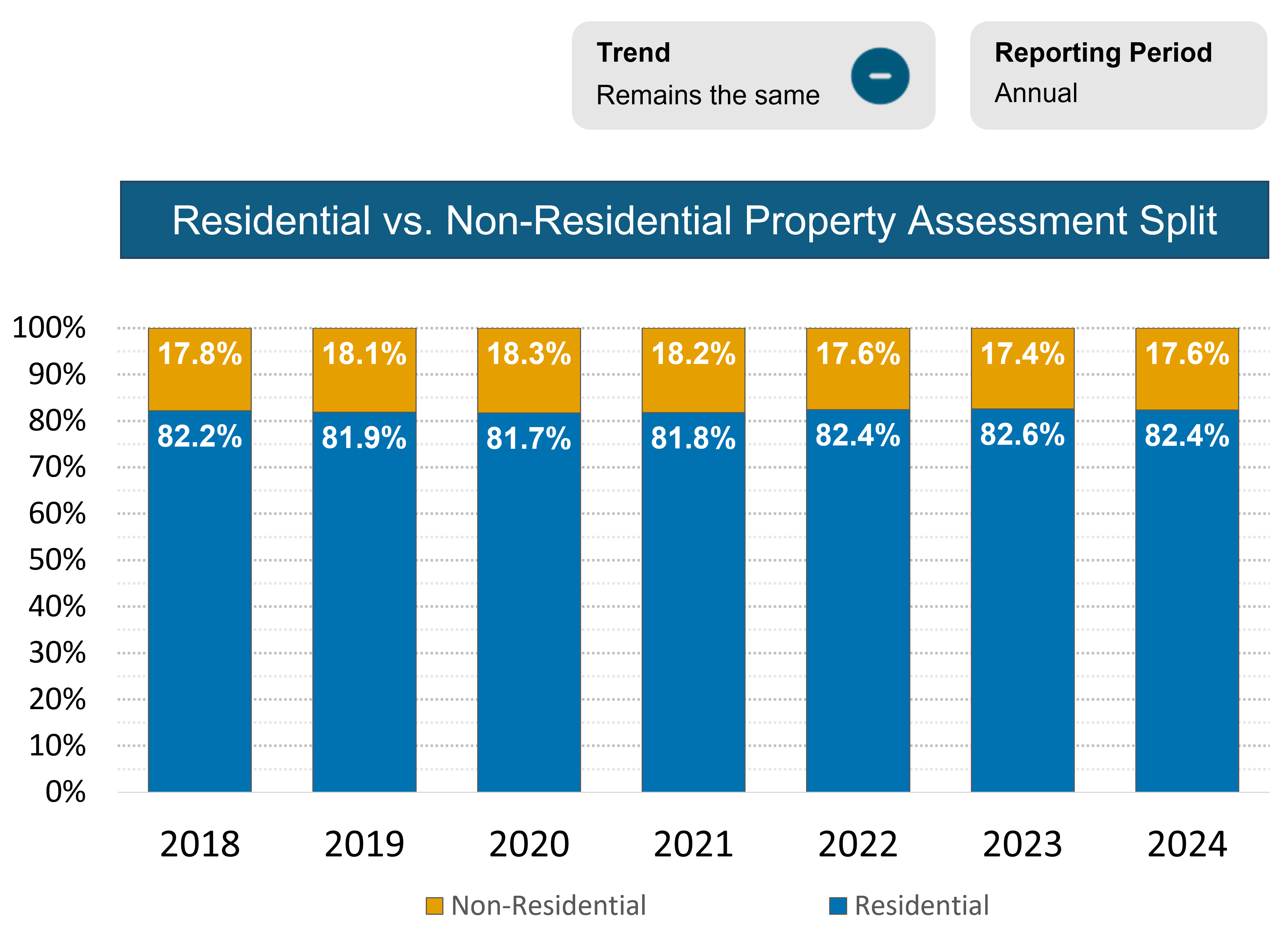
About this data
Debt financing can be used to fund some of the City’s municipal, utility and developer capital projects. This data represents the total amount of debt that has yet to be paid.
How we measure this data
It is calculated by consolidating all the municipal, utility, and developer outstanding debt principal amounts.
Why this measurement is important
Debt levels are monitored to manage the City’s borrowing capacity for future requirements, to maintain maximum flexibility of current funds, and to control the impact that debt charges will have on future tax and utility rates.

About this data
This data represents the growth of property assessment generated from new construction, new land servicing & development activity, and additions or renovations to existing property.
How we measure this data
It is calculated by taking the total assessment generated from new construction, new land servicing & development activity, and additions or renovations to existing property and calculating the percentage increase from prior year's total assessment.
Why this measurement is important
It provides financial context and helps guide future planning and investment decisions.

About this data
This indicator represents the amount of electrical energy produced by converting sunlight into electricity through the City's solar photovoltaic (PV) system.
How we measure this data
As reported by the City's solar photovoltaic (PV) system which tracks real-time and cumulative energy production.
Why this measurement is important
It is essential for monitoring system performance, evaluating financial savings, and assessing environmental impact.

About this data
This indicator represents the amount of greenhouse gas (GHG) emissions prevented as a results of the solar energy produced by the City's photovoltaic (PV) system.
How we measure this data
It is measured by multiplying the greenhouse gas intensity of Alberta’s electricity grid, reported in grams of CO₂-equivalent per kilowatt-hour, by the kilowatt-hours of solar energy produced.
Why this measurement is important
It quantifies the environmental benefits of using clean energy.

About this data
This indicator represents the number of subscribers to the CityPulse bi-weekly e-newsletter.
How we measure this data
As reported by Constant Contact.
Why this measurement is important
It is measured to assess the level of engagement and effectiveness of the information.

About this data
The data represents the average processing time in business days for residential single detached new construction building permits. The processing time does not include any wait times due to revisions and other permit dependencies.
How we measure this data
Permit processing time is calculated from the date a building permit application has been deemed complete and paid for to when the building permit is issued. Any wait times due to revisions and other permit dependencies are subtracted from the processing time.
Why this measurement is important
It is measured to evaluate and monitor the efficiency of permit services and to create transparency around permit processing times.

About this data
The data represents the average processing time in business days for residential semi-detached new construction building permits. The processing time does not include any wait times due to revisions and other permit dependencies.
How we measure this data
Permit processing time is calculated from the date a building permit application has been deemed complete and paid for to when the building permit is issued. Any wait times due to revisions and other permit dependencies are subtracted from the processing time.
Why this measurement is important
It is measured to evaluate and monitor the efficiency of permit services and to create transparency around permit processing times.

About this data
The data represents the average processing time in business days for residential row house new construction building permits. The processing time does not include any wait times due to revisions and other permit dependencies.
How we measure this data
Permit processing time is calculated from the date a building permit application has been deemed complete and paid for to when the building permit is issued. Any wait times due to revisions and other permit dependencies are subtracted from the processing time.
Why this measurement is important
It is measured to evaluate and monitor the efficiency of permit services and to create transparency around permit processing times.

About this data
The data represents the average processing time in business days for residential single detached new construction development permits. The processing time does not include any wait times due to revisions and other permit dependencies.
How we measure this data
Permit processing time is calculated from the date a development permit application has been deemed complete and paid for to when the development permit is approved. Any wait times due to revisions and other permit dependencies are subtracted from the processing time.
Why this measurement is important
It is measured to evaluate and monitor the efficiency of permit services and to create transparency around permit processing times.

About this data
The data represents the average processing time in business days for residential semi-detached new construction development permits. The processing time does not include any wait times due to revisions and other permit dependencies.
How we measure this data
Permit processing time is calculated from the date a development permit application has been deemed complete and paid for to when the development permit is approved. Any wait times due to revisions and other permit dependencies are subtracted from the processing time.
Why this measurement is important
It is measured to evaluate and monitor the efficiency of permit services and to create transparency around permit processing times.

About this data
The data represents the average processing time in business days for residential row house new construction development permits. The processing time does not include any wait times due to revisions and other permit dependencies.
How we measure this data
Permit processing time is calculated from the date a development permit application has been deemed complete and paid for to when the development permit is approved. Any wait times due to revisions and other permit dependencies are subtracted from the processing time.
Why this measurement is important
It is measured to evaluate and monitor the efficiency of permit services and to create transparency around permit processing times.

About this data
This data represents the average number of trips that a resident takes per year.
How we measure this data
It is calculated by dividing the number of passenger trips in a year by the population of the service area.
Why this measurement is important
It is a key indicator for the utilization of transit service in the service area. It also provides insight on changes to residents’ choice of transportation and provides a measure of whether transit growth is keeping pace with population growth.

About this data
This data represents the annual number of hours buses are scheduled to travel on a per capita basis.
How we measure this data
It is calculated by dividing the number of hours buses are scheduled in a year by the population of the service area.
Why this measurement is important
It is a key indicator for the amount of transit services available to residents in the service area.

About this data
This data represents the proportion of water lost through apparent losses (unauthorized consumption, customer metering inaccuracies) and real losses (leakage on transmission, distribution mains and service connections, leakage at reservoirs).
How we measure this data
It is calculated as the percentage difference between the water volume the City purchases and the volume of water the City uses and sells to end users.
Why this measurement is important
It is an important indicator of water distribution efficiency and the state of the City’s water infrastructure.

About this data
This data shows the total number of new dwelling units approved.
How we measure this data
It is calculated by adding up all the new dwelling units from the issued building permits.
Why this measurement is important
It provides insight on the magnitude of current construction, which is an indicator of the overall economic growth of the city.
